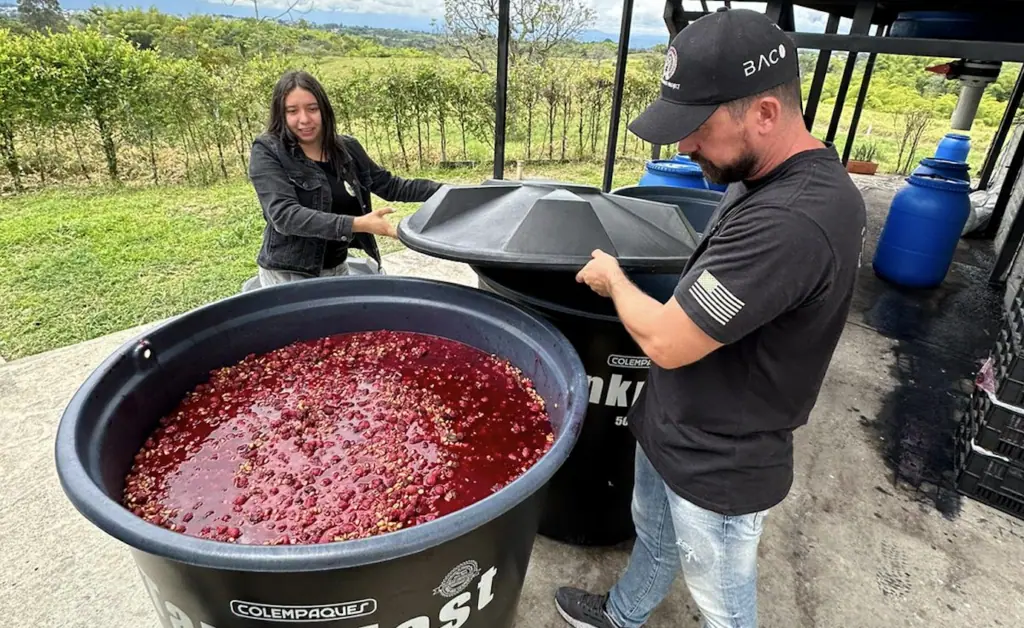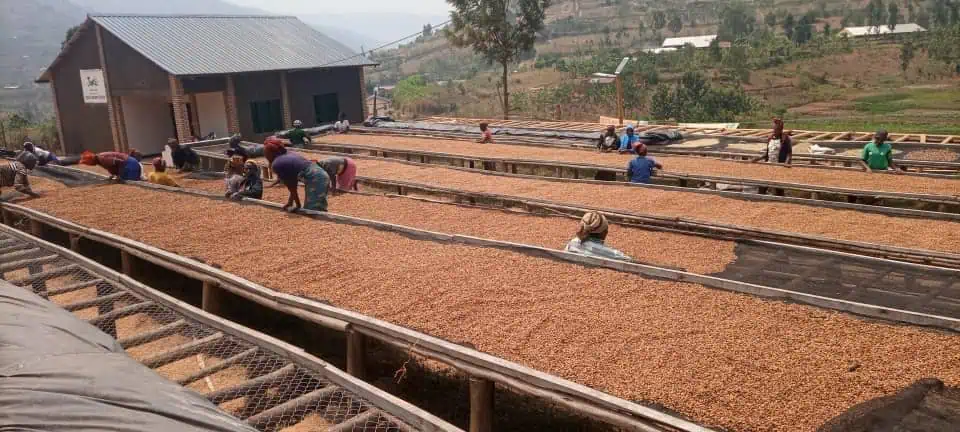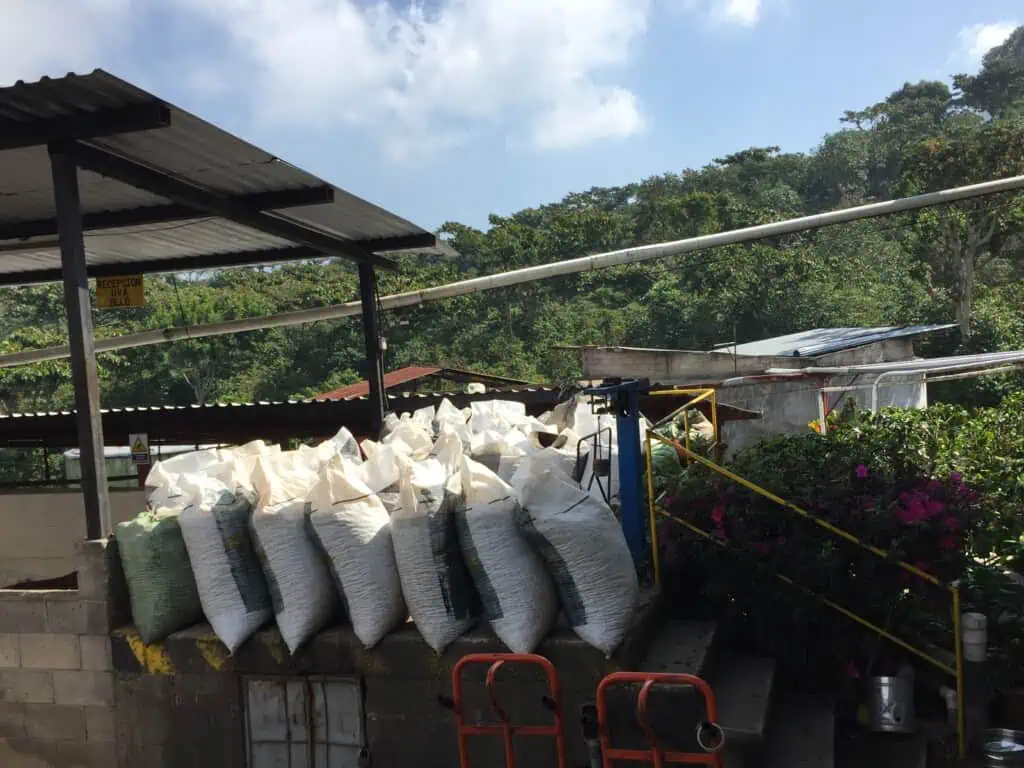
What is a single-origin espresso? Very generally defined, it’s an espresso produced from a single crop of coffee grown and processed in a single country, region, cooperative or farm. In other words, it is not a blend of coffees grown in different places or at different times.
Single-origin (S.O.) espressos allow an espresso drinker to explore the wider world of coffee in the same mindful, informed way as coffee drinkers who taste their coffees brewed as drip or French press. With single-origin espressos, the curious espresso drinker can explore the sensory impacts of variables like tree variety, processing method, growing elevation and, to some degree, roasting strategy — explorations that are difficult to impossible to pursue with blends. Plus, single-origins have the capacity to surprise us, and make the simple act of tasting an espresso shot or cappuccino a memorable mini-revelation that tasting a routine blend, even a very good routine blend, can’t offer us.
Such coffee explorations would seem to be particularly supported by this month’s tasting, as all of the 13 top-rated coffees we report on are identified quite specifically: by specific farm or co-op, by variety of tree that produced them, and often by growing elevation. And we were able to tell something about the roasting by taking Agtron color readings of the beans.
Tasting Colleagues
I was joined in this blind tasting of single-origin espressos by John DiRuocco, vice president of coffee at Mr. Espresso, a long-established (founded in 1978) coffee roaster in Oakland, California. The Mr. Espresso motto, quite justified by its practice, is “Italian inspiration, contemporary taste.”

Kenneth Davids and John DiRuocco tasting espresso coffees at Mr. Espresso roastery in Oakland. Courtesy Jason Sarley.
We conducted the tasting over several days at the lab in the Mr. Espresso roastery, with Brandon Talley, assistant director of coffee quality at Mr. Espresso, pulling the shots on a Faema E71E, and Coffee Review’s Jason Sarley in a supervising support role. As usual, we generated the shots using 18 grams of ground coffee to produce 36 grams of finished espresso, a relatively standard ratio in North American practice. For the “with milk” assessment, the shot was combined with three parts whole milk, heated but not frothed on the steam wand. As always at Coffee Review, the tasting was conducted blind, with Jason delivering the coffees identified only by numbers to John and me.
Importance of Processing Method
When the tasting was finished and the results were tabulated, it turned out that one variable in particular moved to the front of the sensory line: processing method. (Processing method, readers will recall, describes the sequence of procedures that turn the moist seeds of fresh coffee fruit into dry, stable, roaster-ready green coffee beans.) The dramatic impact of processing methods involving anaerobic (limited oxygen) fermentation and its growing number of variations and applications tended to upstage the impact of other variables that create differences among green coffees, like tree variety, growing elevation and various more conventional processing methods.

Old Soul Coffee’s Natural Process “Unicorn Lot” drying at Anny Ruth Pimentel’s Finca Loma La Gloria in El Salvador. Courtesy of Jason Griest.
Thirteen of the coffees we tested achieved ratings of 94 or 95, all of which we review here. Among those top-rated 13 samples, nine, or almost 70 percent, were processed using methods that prominently incorporated anaerobic fermentation. Among the remaining four top-rated samples, two were processed by the conventional wet or washed method (all soft fruit residue was removed from the beans before they were dried), one by the honey or pulped natural method (skins were removed, but the fruit flesh or mucilage remained on the beans during drying), and one by the natural method (the beans were dried inside the entire fruit).

A stage in the multi-staged fermentation procedure for Royal Flamingo Coffee’s Colombia Red Fruits at Edwin Noreña’s Campo Hermosa in Colombia. Courtesy of Royal Flamingo Coffee.
The impact of the anaerobic ferment could be felt in the often striking sweetness and surprising aromatic complexity among all of the nine anaerobic-process samples. However, the only sample that displayed explicit anaerobic character in its candyish sweetness and perfume-like flowers was the Royal Flamingo Colombia Red Fruits Campo Hermosa Edwin Noreña (94). John very much admired this coffee at 95 and felt it was coherent and complete in its originality, with its intense aromatics supported by a sound structure. For me, however, there was a bit too much strawberry gummy and not quite enough coffee, though I managed a 92. But I suspect many readers will go with John’s take on this one. Give this striking coffee a try.
John and I switched sides with the quietly melodic, elegant Speckled Ax Ethiopia Dame Dabaye (John 92, Ken 95, net 94), which I found pure, poised and flawless. John found it a pleasing but straightforward washed Ethiopia espresso. But, again, try it; you may not be blown away, but I strongly doubt you will throw any of it away either.
Tree Variety
The celebrated Geisha/Gesha variety of Arabica, with its elongated beans, fine structure, and intensely floral, cocoa and stone-fruit character, has been one of the main vehicles that ambitious coffee growers have relied on over the past couple of decades in their often successful attempts to differentiate their green coffees and attract recognition and higher prices for them. Authentic Geishas, particularly those grown from seed of the original Panama strain (Geisha T2722), continue to impress with their grand but balanced structure and intense floral, fruit and cocoa aromatics.

Young coffee trees at Edwin Noreña’s Campo Hermosa in Colombia.
But Geishas may no longer seem as new and different as they once did. So applying anaerobic processing to a coffee from a respectable but otherwise unremarkable tree variety is an alternative way to surprise the buyer with aromatic fireworks and seductive sweetness. And at lower prices than might be expected for coffee from Geisha trees, with their often stingy yields and fussy needs. Of course, producers can double down and apply anaerobic processing to their Geishas, as is the case with the Big Shoulders Coffee’s anaerobic natural Marcela Gesha Espressso (95), Euphora Coffee’s anaerobic washed Colombia Buenavista Ataraxia Geisha (94), and AOI Coffee’s Ethiopia Growers Reserve Gesha Village Gaylee Special Fermentation (94), all of which pursue a distinctive cup by means of both distinctive tree variety and anaerobic processing.
Origin and Single-Origin Espressos
Seven of this month’s 13 highest-rated samples were produced in Colombia, all in southern or south-central Colombia. Of the remaining six, three were produced in Ethiopia, one in Rwanda, one in El Salvador, and one in Hawaii.
Why the preponderance of Colombias, obviously a popular origin, but until recently not the go-to origin for coffees intended for espresso? (Traditionally, that would be Brazil.) Mainly because a cluster of farms in southern Colombia appear to have mastered the use of complex methods of anaerobic fermentation, which, performed skillfully, can transform a high-grown, potentially acidy coffee into a lower-toned, richly complex, espresso-friendly coffee.

MK Coffee’s Rwanda Rulindo Red Bourbon drying in the “honey (fruit flesh) at Juru Coffee in Rwanda. Courtesy of Linking Coffee and Juru Coffee.
True, some of the other successful coffees in this month’s tasting used simpler, more direct applications of anaerobic methods than the Colombia farms. But, all in all, only two out of this month’s top-rated 13 samples were processed using legacy methods traditionally associated with the origins that produced them: The Wonderstate Colombia Sierra Morena Pink Bourbon (95) is a traditional washed-process Colombia, and the Speckled Ax Ethiopia Dame Dabaye (94) a traditional washed Ethiopia. Local tree variety may contribute to the success of MK Coffee’s Juru Rwanda Rulindo Red Bourbon Honey (94), though the honey processing method is atypical for a Rwanda.
Stay tuned, but it appears that the expectation that we can make consistent associations between coffee origin and coffee cup character continues to erode as ambitious farmers all over the world tinker with tree variety (e.g., Geisha) and processing method.
Roast Color and Espresso
Traditionally, Italian practice is to roast for espresso to around what Americans might call a darkish medium roast. However, when a taste for espresso drinks and European-style cafés first developed in the U.S. in the 1980s, roasters went really dark for espresso brewing. They aggressively dark-roasted high-grown Central America or Colombia coffees, producing intense, bitter coffees that required the softening, buffering impact of hot frothed milk to render them drinkable. Later, many American specialty roasters migrated toward something more like the original Italian tradition: moderately dark- to medium-dark.
Today, of course, on the leading edge of the U.S. specialty coffee scene, taste in roast style has completely flipped, regardless of brewing method. Rather than everything dark, as was the case 20 years ago, today virtually everything is light. Sometimes very light, regardless of intended brewing method.
Of the seven U.S. coffees reviewed this month, six are light-roasted. Only one, the Speckled Ax Ethiopia, was roasted modestly darker, to a little past second crack, classifying it as a moderately dark roast. The six coffees from Taiwan roasters were a bit darker roasted than the U.S. samples, tending toward medium or medium-dark, though none could be called outright dark roasted.
Omni Roasts and Acidity
Most of this month’s coffees probably qualify as what some in the coffee world call omni roasts—roasts that the roaster feels will do well when subjected to almost any brewing method.
This practice—one roast for all brewing methods—has a practical advantage for coffee sellers, of course. Fewer products, a more compact inventory, and perhaps simpler communication. The increased technical sophistication available today in managing roast, facilitated by computer control and monitoring, may help roasters apply roasting practices that tend to round sharpness and soften and integrate acidity in lighter roasts, making them more espresso-friendly.
The potentially bright, aggressive acidity characteristic of high-grown, light-roasted coffees has always presented a problem for espresso brewing. Some years ago, when the practice of pulling espresso from such bright, lighter-roasted coffees took off, I recall tasting some rather imbalanced espressos. Although we still run into an occasional rather sharply acidy single-origin espresso at Coffee Review, our tasting for this month suggests that roasters are becoming increasingly skillful at sourcing and light-roasting single-origins for all-purpose brewing, and, by implication, for espresso.
Acid-Reducing Anaerobics
The fact that there were so many anaerobic-fermented coffees among the espressos we tasted this month may have helped the acidity-reducing cause. Anaerobic processing tends to reduce or soften acidity, often replacing it with a backgrounded lactic tang, while encouraging a sweetness that helps balance any bitter edge to the acidity.
Single-Origin Espressos in the Café
When we decided on this month’s topic, we were a little afraid that single-origin espressos had had their day and were on their way out of fashion.
Perhaps. However, we received a reassuringly large number of submissions for this topic.
Roasters who sent us top-rated coffees and with whom we subsequently corresponded were largely divided about the value of single-origin espressos in their cafés. Generally, Taiwan roasters were more positive than were North American roasters, and for good reason, given brewing espresso at home appears more popular in Taiwan than in the U.S. Mark Shi of Taiwan’s MK Coffee reports: “Since Taiwanese cafes banned on-site drinking during the Covid-19 pandemic and most customers were working from home, I found that many people who drank coffee every day bought automatic espresso machines at that time, so for the beans suitable for espresso (including blended beans and single-origin beans), the demand is trending higher and higher.”
Arthur Chen of Taiwan’s Balmy Day Coffee Office (Ethiopia Anaerobic Washed G1 Wild Rose S.O. Sidamo, 94), offers an extended recommendation for how roasting for espresso should be conducted (slowly), concluding that single-origin espressos “… should be like a taste bomb, allowing the flavor of the coffee to be concentrated and focused, so that the single-origin coffee flavor can bloom in the mouth like fireworks.”
American Single-Origin Skeptics
A generally more skeptical attitude among American roasters regarding single-origin espressos is voiced by Old Soul Coffee’s Jason Griest (El Salvador Finca Loma La Gloria Natural Process “Unicorn Lot”, 94). Jason writes, “Single origin espressos can be fun, but we find a ‘good’ one elusive to find and so, rarely have one on the bar at our shops.” Jason echoes the position of many North American roasters, who feel that an espresso coffee needs to be versatile above all: “Our main espresso blend called The Remedy is made up of three components, designed to complement each other in terms of body, acidity and sweet/bitter notes that can be enjoyed both as a straight shot and with milk.” Lee Paterson of Hawaii’s Hula Daddy (Kona Espresso Special Selection, 94) points out that “Since most of our sales are to North America, where drip coffee is king, espressos are a small part of our business.”

Anny Ruth Pimentel’s Finca Loma La Gloria in El Salvador. Courtesy of Jason Griest.
Tim Coonan of Big Shoulders Coffee (Marcela Gesha Espresso, 95) takes a more encouraging middle-ground position: “Our S.O. espresso program serves three purposes. These are coffees that are challenging for roasters and baristas alike. So it’s educational for us. We find these are appreciated by those regular customers who are looking for an opportunity to both learn more about coffee and also [are] willing to explore some boundaries in the process. These are customers who also enjoy their espresso solo, not with milk.”
American Single-Origin Enthusiasts
Taking a wholehearted pro-single-origin position are Bryan and Beth Brzozowski of Royal Flamingo Coffee (Colombia Red Fruits Campo Hermosa Edwin Noreña, 94), who are planning to extend their successful e-commerce and wholesale business to a brick-and-mortar café this year. They write, “Single-origin espresso is something we’ve become known for in our coffee community and has played a major role in our e-commerce and wholesale growth. When we open our café next month, we’ll be leaning hard on single-origin espresso. … For example, we’re planning to have a few options on the menu where customers can order a drip and a shot of single-origin espresso comes alongside (a pair we are calling the Barista’s Boilermaker).”

Wilson Alva of Finca Sierra Morena, producer of Wonderstate Coffee’s Colombia Sierra Morena Pink Bourbon. Courtesy of The Coffee Quest.
Summing up the pro-single-origin side is Caleb Nicholes of Wonderstate Coffee: “We believe that single-origin espressos have a distinct and important role in specialty coffee. In all of our café locations, we offer both a single-origin espresso, which is roasted lighter, as well as a deeper roasted blend. Having a lighter-roasted espresso option gives us the opportunity to introduce our customers to a very light-roasted espresso experience that is very much reflective of a coffee’s variety, micro-climate and processing style. While brighter, more fruit-driven and aromatic espressos can be jarring for some coffee consumers, it is an excellent way to expand perceptions around what espresso can be. We love to surprise our customers with something they have never tasted before, and single-origin espresso is one of the best ways we have found to do that.”
Single-Origin Espressos at Home
Of course, café owners need to please nearly everyone who comes in the door. Consumers only need to please themselves—or at most their families and guests. So perhaps the single-origin espresso game, with its potential for coffee exploration and sensory revelation (along with its risk for temporary disappointment) is best played by consumers at home. If so, we feel that the coffees we review this month offer an excellent and diverse starting point.
John DiRuocco Reflects on the Tasting
John writes: “Roasters from all over the world submitted their finest offerings from familiar to exotic. It was an exciting challenge to describe and evaluate these coffees. The vast assortment of processes and varieties translated to a thrill ride of aroma, acidity, and fruit. As a roaster based in Italian coffee tradition, our approach to espresso at Mr. Espresso is based on the idea of balance and roundness, something that can be enjoyed several times a day, every day. What set the best of the coffees we tasted apart for me were not only flavor profiles that contained explosive fruits, intricate floral flavors, and intense acidity, but those that were balanced by a pronounced sweetness and round body to create a memorable espresso experience.”
Thanks to the roasters who greatly enriched this report by sharing their ideas and experience regarding single-origin espresso coffees: Matt Bolinder, Speckled Ax Coffee; Bryan and Beth Brzozowski, Royal Flamingo Coffee; Chris Chao, AOI Coffee Roaster; Arthur Chen, Balmy Day Coffee Office; Tim Coonan, Big Shoulders Coffee; Jason Griest, Old Soul Coffee Co.; Albert Hsu, OLI Cafe; Miguel Meza, Paradise Coffee; Caleb Nicholes, Wonderstate Coffee; Lee Paterson, Hula Daddy Kona Coffee; Mark Shi, MK Coffee Roasters; May Wang, Euphora Coffee; Zhou Tzuchiang, Bargain Cafe.



